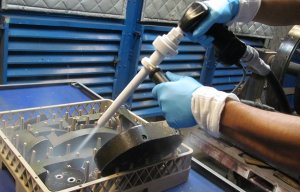
Cold Jet to showcase dry ice blasting technology at SAMPE Seattle
Electromagnetic fields are applied to nanoparticles leading to a controlled heating.

3rd April 2023
Innovation in Textiles
|
Aachen, Germany
Researchers at RWTH Aachen University in Germany have developed an electromagnetically heatable, nanomodified stent for the treatment of hollow organ tumours.
They explain that almost every fourth person who eventually dies of cancer has a hollow organ tumour, for example in the bile duct or in the oesophagus. Such a tumour cannot usually be removed surgically. It is only possible to open the hollow organ for a short time using a stent – a tube-shaped prosthesis. However, the tumour grows back and penetrates the hollow organ through the stent.
The new technology has been developed by Ioana Slabu from Aachen’s Institute of Applied Medical Technology and Benedict Bauer from the Institute of Technical Textiles.
When electromagnetic fields are applied to the stent, its nanoparticles lead to a controlled heating. Because the tumour reacts much more sensitively to heat than healthy tissue, it is destroyed and the hollow organ remains open, creating a self-cleaning effect.
“Not only can we drastically reduce treatment costs, but above all we can provide relief for millions of patients worldwide,” explains Slabu.
A manufacturing process and proof of concept for magnetic hyperthermia are already in place and the technology has a very high development potential because it can also be used for tumours in other parts of the body such as the prostate, stomach, intestine or urinary bladder, or for cardiovascular diseases.

Business intelligence for the fibre, textiles and apparel industries: technologies, innovations, markets, investments, trade policy, sourcing, strategy...
Find out more